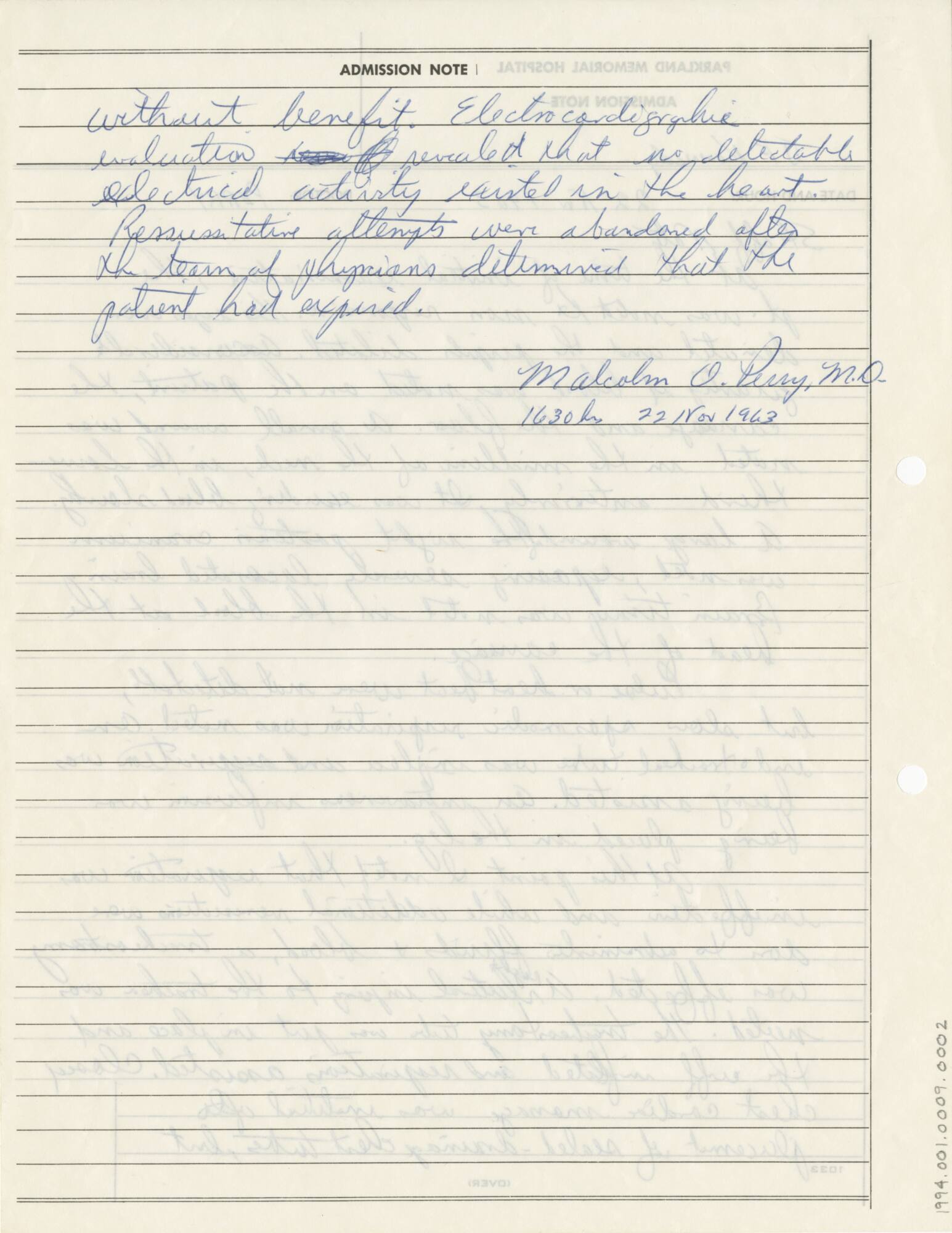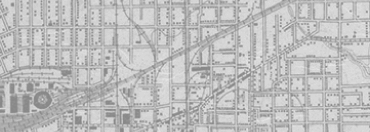


Back
Dr. Malcolm Perry's Statement of Activities
Two-page document handwritten by Dr. Malcolm Perry less than four hours after the 12:30 p.m. shooting of President Kennedy. Dr. Perry was the among the doctors who played an active role in the treatment of President Kennedy. He performed a tracheotomy on the president's neck by cutting an opening through a bullet exit hole just below the Adam's apple.
Dr. Malcolm Perry's Statement of Activities
11/22/1963
Paper
11 × 8 1/2 in. (27.9 × 21.6 cm)
Parkland Hospital Collection/The Sixth Floor Museum at Dealey Plaza
1994.001.0009.0002
Among the Parkland Memorial Hospital doctors in Trauma Room One on November 22, 1963, Dr. Malcolm O. Perry (1929-2009) was probably the most reluctant to share his experiences beyond a couple of initial press interviews immediately after the assassination and his formal testimony before both the Warren Commission in 1964 and the Assassination Records Review Board in 1998. He frequently turned down (or simply ignored) book interviews, documentary requests and several invitations to participate in the Museum's Oral History Project. I once had the chance to meet Dr. Perry while visiting another Parkland physician, the late Robert McClelland, at his office in 2001. Perry was headed out, while I was headed in. We met, and he very cordially shook hands with me. However, upon learning that I was from The Sixth Floor Museum and there to record an interview with Dr. McClelland, Dr. Perry's friendly demeanor changed, and he very quickly excused himself. "Malcolm never wanted to talk about it," Dr. McClelland recalled shortly after Perry's death in 2009. "I think he had a bad experience with the press right after, and I think that may have colored his lack of willingness to talk." Dr. Perry's "bad experience" stemmed from the controversy surrounding initial comments that he made shortly after the assassination, when he stated that the small wound near President Kennedy's Adam's apple may have been an entry wound (suggesting a shot from the front, the grassy knoll area). This was complicated by the fact that Perry had enlarged the existing wound in order to insert a breathing tube into the president's trachea, a detail which the autopsy doctors did not know at the time they examined the president's body late that night at Bethesda Naval Center. Perry later changed his mind and testified to the Warren Commission that the bullet hole he enlarged was likely an exit wound, supporting the lone gunman theory, but for many researchers, his initial statement remains proof of a second gunman in Dealey Plaza. -- Stephen Fagin, Curator

Dr. Malcolm Perry's Statement of Activities
Two-page document handwritten by Dr. Malcolm Perry less than four hours after the 12:30 p.m. shooting of President Kennedy. Dr. Perry was the among the doctors who played an active role in the treatment of President Kennedy. He performed a tracheotomy on the president's neck by cutting an opening through a bullet exit hole just below the Adam's apple.
Dr. Malcolm Perry's Statement of Activities
11/22/1963
Emergency care
Emergency room
Medical notes
Kennedy, John F.
Perry, Malcolm O.
Parkland Hospital
Dallas
Paper
11 × 8 1/2 in. (27.9 × 21.6 cm)
Parkland Hospital Collection/The Sixth Floor Museum at Dealey Plaza
1994.001.0009.0002
Among the Parkland Memorial Hospital doctors in Trauma Room One on November 22, 1963, Dr. Malcolm O. Perry (1929-2009) was probably the most reluctant to share his experiences beyond a couple of initial press interviews immediately after the assassination and his formal testimony before both the Warren Commission in 1964 and the Assassination Records Review Board in 1998. He frequently turned down (or simply ignored) book interviews, documentary requests and several invitations to participate in the Museum's Oral History Project. I once had the chance to meet Dr. Perry while visiting another Parkland physician, the late Robert McClelland, at his office in 2001. Perry was headed out, while I was headed in. We met, and he very cordially shook hands with me. However, upon learning that I was from The Sixth Floor Museum and there to record an interview with Dr. McClelland, Dr. Perry's friendly demeanor changed, and he very quickly excused himself. "Malcolm never wanted to talk about it," Dr. McClelland recalled shortly after Perry's death in 2009. "I think he had a bad experience with the press right after, and I think that may have colored his lack of willingness to talk." Dr. Perry's "bad experience" stemmed from the controversy surrounding initial comments that he made shortly after the assassination, when he stated that the small wound near President Kennedy's Adam's apple may have been an entry wound (suggesting a shot from the front, the grassy knoll area). This was complicated by the fact that Perry had enlarged the existing wound in order to insert a breathing tube into the president's trachea, a detail which the autopsy doctors did not know at the time they examined the president's body late that night at Bethesda Naval Center. Perry later changed his mind and testified to the Warren Commission that the bullet hole he enlarged was likely an exit wound, supporting the lone gunman theory, but for many researchers, his initial statement remains proof of a second gunman in Dealey Plaza. -- Stephen Fagin, Curator










